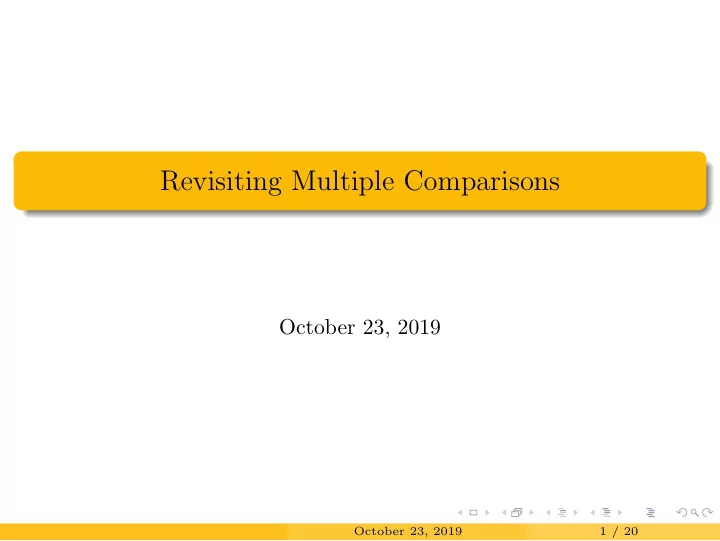

Revisiting Multiple Comparisons October 23, 2019 October 23, 2019 1 / 20
Week 5 Lab B (Wed/Thurs) is cancelled. Lab A will be dedicated to midterm review. There will be no lab due. (But we might have something small for you to turn in during your Lab A.) October 23, 2019 2 / 20
Post Hoc Tests Another term for multiple comparisons is post hoc tests (analyses done after an ANOVA). For a factorial experiment, we have three possible sets of comparisons. 1 Means for factor A 2 Means for factor B 3 Means for the factor level combinations (relating to interaction) Section 11.10 (Mendenhall, Beaver, & Beaver) October 23, 2019 3 / 20
Post Hoc Tests For the previous example, we have factor level combinations 1 Supervisor 1 with Day Shift 2 Supervisor 1 with Swing Shift 3 Supervisor 1 with Night Shift 4 Supervisor 2 with Day Shift 5 Supervisor 2 with Swing Shift 6 Supervisor 2 with Night Shift This results in k ( k − 1) = 6 × 5 = 15 possible pairs. 2 2 Section 11.10 (Mendenhall, Beaver, & Beaver) October 23, 2019 4 / 20
Revisiting Multiple Comparisons While the Bonferroni correction is effective and a standard approach in many fields, it represents a ”worse case scenario” approach. This means it can sometimes be too aggressive. Naturally, this may not always be ideal. We want other options! Section 11.10 (Mendenhall, Beaver, & Beaver) October 23, 2019 5 / 20
Tukey’s Honest Significant Difference For Tukey’s method for paired comparisons The Type I error will be α . The ANOVA assumptions are necessary. But if we do these tests post-ANOVA, these are already satisfied. In addition, we must have independent sample means and equal group sizes. Section 11.10 (Mendenhall, Beaver, & Beaver) October 23, 2019 6 / 20
Tukey’s Honest Significant Difference We will compare a value ω to differences in population means. This represents the honest significant difference . If | ¯ x i − ¯ x j | > ω , we conclude that µ i is different from µ j . Section 11.10 (Mendenhall, Beaver, & Beaver) October 23, 2019 7 / 20
Tukey’s Honest Significant Difference � s � ω = q α ( k, d f ) √ n t where k = number of treatments (factor level combinations) s 2 = MSE, the estimate of the common variance σ 2 f = degrees of freedom for s 2 =MSE d n t = the number of observations in each treatment q α ( k, d f ) comes from Tukey’s table of critical values Section 11.10 (Mendenhall, Beaver, & Beaver) October 23, 2019 8 / 20
Example Suppose you want to make pairwise comparisons for an ANOVA k = 5 means α = 0 . 05 s 2 has 9 d f Section 11.10 (Mendenhall, Beaver, & Beaver) October 23, 2019 9 / 20
Tukey’s Table of Critical Values Section 11.10 (Mendenhall, Beaver, & Beaver) October 23, 2019 10 / 20
Example We have an experiment to determine the effect of nutrition on attention span of elementary school students. 15 students were randomly assigned to each of three meal plans: no breakfast light breakfast full breakfast Attention spans were recorded during a morning reading. Section 11.10 (Mendenhall, Beaver, & Beaver) October 23, 2019 11 / 20
Example The ANOVA table for this experiment (from R ) is: > summary(aov(span~trt)) Df Sum Sq Mean Sq F value Pr(>F) trt 2 58.53 29.267 4.933 0.0273 * Residuals 12 71.20 5.933 What can we conclude? Section 11.10 (Mendenhall, Beaver, & Beaver) October 23, 2019 12 / 20
Example Calculate Tukey’s yardstick for this ANOVA. Section 11.10 (Mendenhall, Beaver, & Beaver) October 23, 2019 13 / 20
Tukey’s Table of Critical Values Section 11.10 (Mendenhall, Beaver, & Beaver) October 23, 2019 14 / 20
Example Treatment Mean Standard Deviation No Breakfast 9.4 2.30 Light Breakfast 14 2.55 Full Breakfast 13 2.50 Section 11.10 (Mendenhall, Beaver, & Beaver) October 23, 2019 15 / 20
Tukey’s Method in R > TukeyHSD(aov(span~trt)) Tukey multiple comparisons of means 95% family-wise confidence level Fit: aov(formula = span ~ trt) $trt diff lwr upr p adj light-full 1.0 -3.110011 5.1100111 0.7963670 none-full -3.6 -7.710011 0.5100111 0.0886624 none-light -4.6 -8.710011 -0.4899889 0.0284289 Section 11.10 (Mendenhall, Beaver, & Beaver) October 23, 2019 16 / 20
Example: Tukey’s Method for More Complex ANOVAs We will bring our example back to the supervisor and shift problem. We know there is a difference between the two supervisors. We will use Tukey’s approach to compare each treatment (factor level combination). Section 11.10 (Mendenhall, Beaver, & Beaver) October 23, 2019 17 / 20
Example The ANOVA we found last class was Source d f SS MS F Supervisor (A) 1 19208 19208 26.68 Shift (B) 2 247 123.5 0.17 Interaction (AB) 2 81127 40563.5 56.34 Error 12 8640 720 Total 17 109222 Section 11.10 (Mendenhall, Beaver, & Beaver) October 23, 2019 18 / 20
Example Our treatment means looked like Shift Supervisor Day Swing Night 1 602 498 450 2 487 602 657 There are k = 6 treatments. Section 11.10 (Mendenhall, Beaver, & Beaver) October 23, 2019 19 / 20
Example s2night s1day s2swing s1swing s2day s1night s2night - 55 55 159 170 207 s1day - - 0 104 115 152 s2swing - - - 104 115 152 s1swing - - - - 11 48 s2day - - - - - 37 s1night - - - - - - Section 11.10 (Mendenhall, Beaver, & Beaver) October 23, 2019 20 / 20
Recommend
More recommend